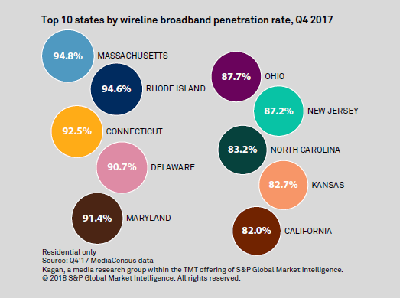The U.S. wireline broadband penetration rate ticked up 1.1 percentage points in 2017, but large swaths of the continental U.S. remain underpenetrated. The latest footprint analysis from Kagan, a media research group within S&P Global Market Intelligence, for the top 10 wireline broadband providers again underscores the stark contrast between the coasts and the heartland.
The maps of the top service providers' geographic areas of operations as of December 31, 2017 are available here in PDF format.
The residential wireline broadband universe gained 2.3 million customers in 2017, reaching an aggregate 94.8 million. The top 10 wireline ISPs served an estimated 87.3 million subscribers, or a calculated 92.1 percent of the U.S. residential total at the end of the period. Roughly 28.9 million U.S. occupied households did not take wireline high speed internet as of December 31, 2017.
The top three ISPs alone, Comcast Corp., Charter Communications Inc. and AT&T Inc., served a calculated 64.1 percent of the U.S. total. At the end of 2017, leader Comcast reported 23.9 million residential broadband subscribers across a footprint that includes the bulk of the nation's largest cities, essentially along the coasts and across the Midwest. California is Comcast's largest state by customers with an estimated 2.7 million. Florida is a relatively distant second with an estimated 2.2 million.
Charter reported 22.5 million residential wireline broadband subscribers in fourth quarter 2017. The MSO's footprint, which combines the legacy Bright House Networks LLC, Charter and Time Warner Cable Inc.systems, shows a greater continental spread than that of competitor Comcast. That said, the operator also has a strong coastal presence, with California, New York, North Carolina and Florida accounting for a combined 10.3 million subs.
Ranking a distant third by subscribers, privately owned Cox Communications Inc. has a much smaller footprint than its larger public peers. The bulk of Cox's HSD customers are located in the heartland states of Arkansas, Kansas and Oklahoma; Louisiana; and the Southwest, notably Arizona, southern California and Nevada, where Cox has a combined 2.5 million residential wireline HSD subs, or 47 percent of the company's total. Cox also has more than 500,000 residential broadband customers in Virginia, according to estimates.
Through its Optimum, i.e., former Cablevision Systems Corp., and Suddenlink Communications assets, Altice USA Inc. reported more than 4 million residential wireline broadband subscribers at year-end 2017, including an estimated 1.6 million in New York alone.
Combined, the cable operators in the top 10 wireline broadband providers had 56.8 million residential high-speed data customers at the end of 2017, accounting for 65 percent of the top 10's total.
AT&T dominates across the telco platform. The Dallas-based telecommunications giant in fourth quarter 2017 reported 14.4 million residential wireline broadband subscribers across a footprint heavily weighted toward the Central Gulf, Central South and South Atlantic regions, California and Nevada. Kagan estimates AT&T had a combined 5.8 million wireline HSD customers across California, Florida and Texas at the end of 2017.
Verizon Communications Inc. is a distant second, with less than half of AT&T's subscriber count. Verizon serves wireline broadband across 10 states. New York, Pennsylvania and Virginia were the telco's largest states by subscribers, accounting for a combined 3.5 million subs. CenturyLink Inc. rounds out the telco top three with 5.1 million residential subs across 36 states, and a strong presence in the Northwest, as of December 31, 2017.

